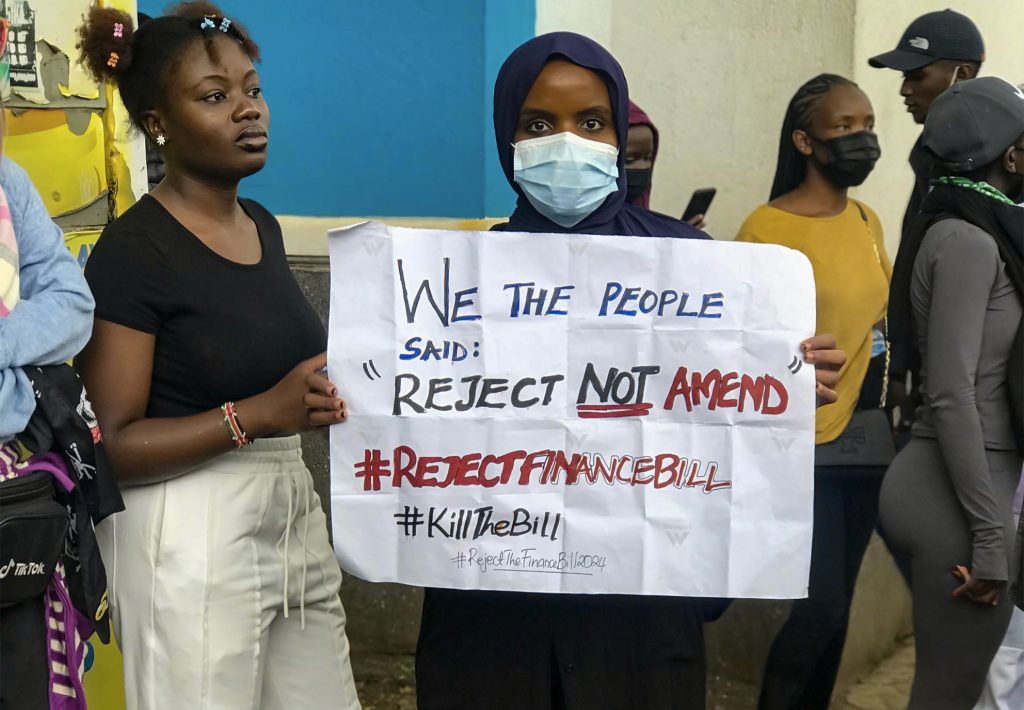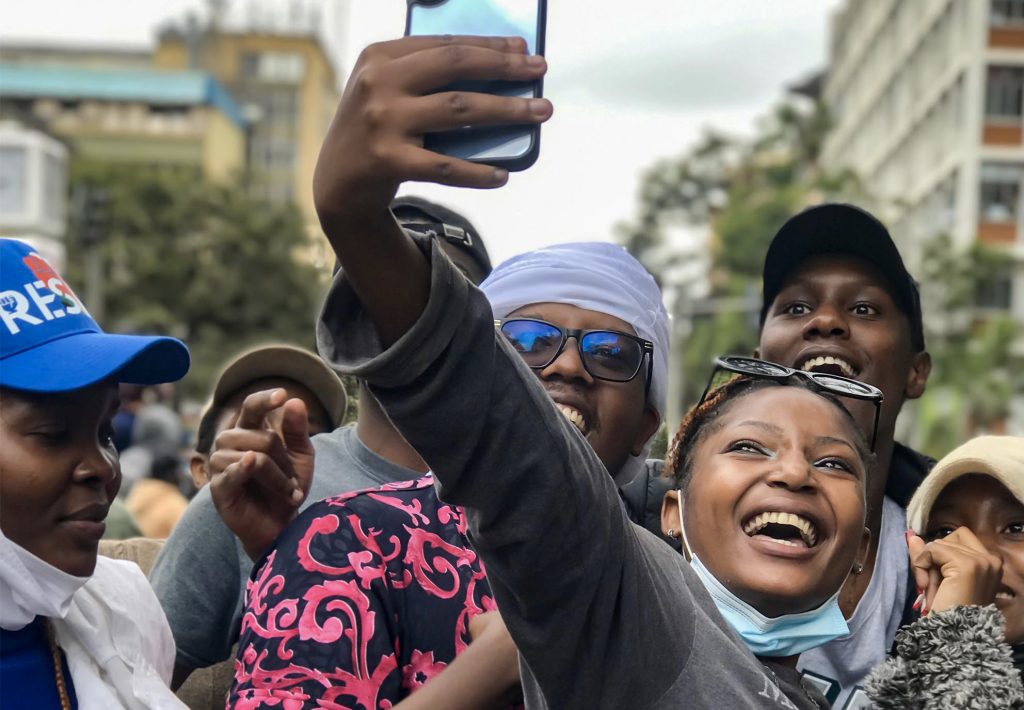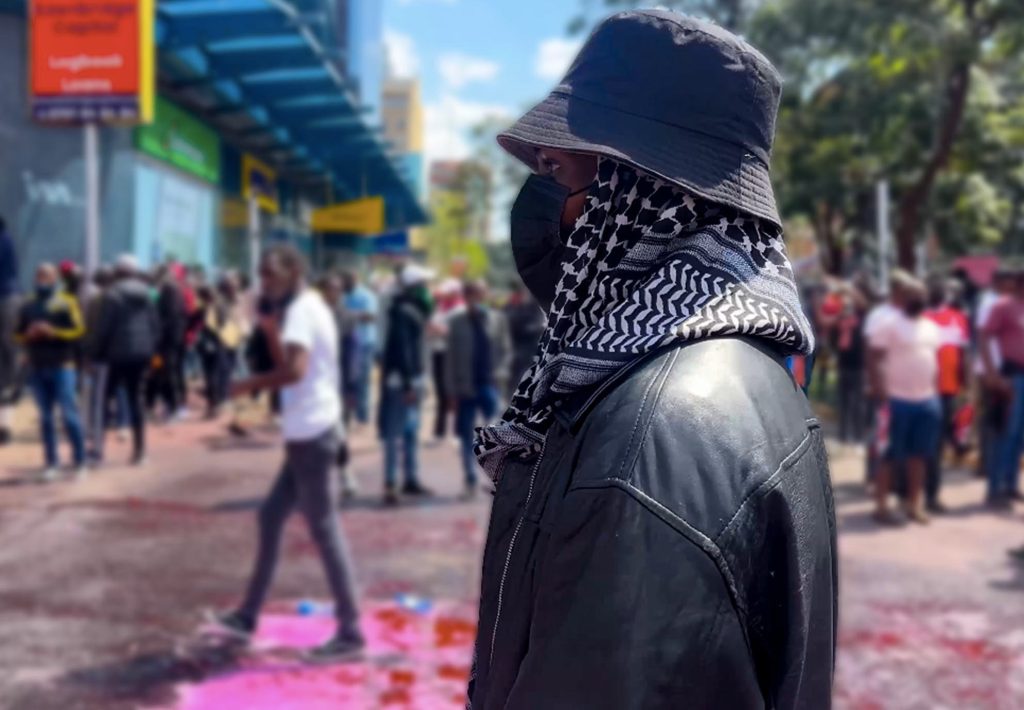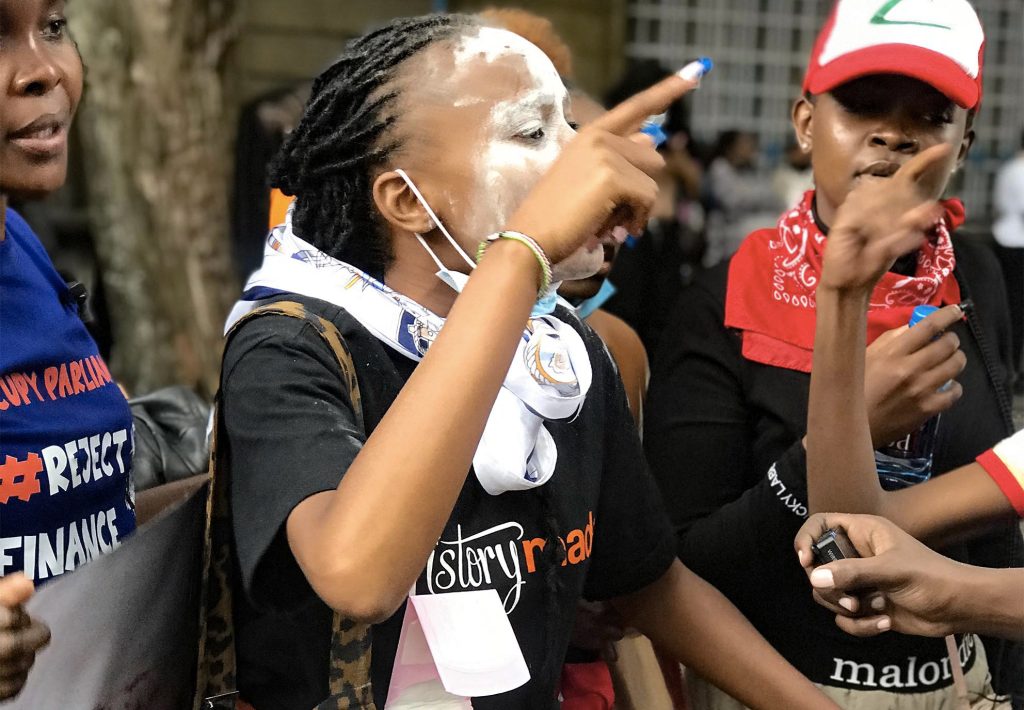Recent protests in Kenya point to a change like youth involvement in African governance. The rise of social media and civic engagement has enabled a demographic previously perceived as apathetic to get involved in socio-economic development policies.
A pink-coloured water cannon is aimed at the protestors, who are shouting ‘haki yetu, haki yetu’ (our right! Our right!). Quickly dispersed by the high-pressure water and teargas, one group sings the Kenyan national anthem, waving small Kenyan flags. The images soon trend across most social media platforms and, before the day is out, make headlines worldwide.
Among the protesters is William Sakawa, a journalist, producer, and content creator. He’s dressed in all black and has a black-and-white keffiyeh tied around his neck and covering part of his head.
While protesting, he repeatedly posts, engaging his fellow young Kenyans in discussions about why the country’s Finance Bill 2024 should not become law.
Back at his office, Sakawa calmly scrolls through social media to catch up with the latest on the protests. The protests are now in their second week, and an unconfirmed number of protesters have lost their lives. For Sakawa, these protests are the continuation of a tradition of social protest that began in Kenya during the presidency of Daniel Arap Moi.
“This is not the first protest. We have had different generations. In the 90’s we had the Mwakenyas, so these problems have always been there. But what I feel is that the pressure was building, and everything got to a breaking point. This felt like it,” said Sakawa, an activist with the Communist Party of Kenya.

The Finance Bill 2024, described as punitive by the protesters, sought to raise taxes on essential services and items, including diapers, sanitary pads, and internet data. While offered as a solution to lower Kenya’s national debt, the bill came when the country’s youth – Kenya and Africa’s largest demographic – was grappling with unemployment and the highest inflation rate in decades.
The bill was meant to increase domestic revenue by US$2.7 billion but followed a series of other taxes, including the country’s controversial Housing Levy, which imposes a mandatory three per cent on all salaried employees to help pay for affordable housing in the country.
The movement against the bill was born in digital spaces. On the first day of protests, X (formerly Twitter), Instagram and TikTok featured young protestors gathering in highly organised and well-curated, peaceful demonstrations on the streets of downtown Nairobi and in other city centres across the country. Resplendent in highly photogenic, trendy and colourful attire, protesters held placards and carried the Kenyan flag in a carefully choreographed show of unity and solidarity not seen before in Kenya. The protesters used the hashtag #RejectFinanceBill2024 and popularised the mantra, “Rage and Courage”. The protests soon became known as the Gen Z Protest, reflecting the demographic and the protesters’ digital skills.
“I think Kenyans remember pretty well. He [President Ruto] had a very clear manifesto when he was campaigning: ‘I’ll deal with corruption; I’ll form a state capture inquiry. I’ll curb borrowing,’ but then he got to power, and his pledges to work for the poor people, the working class suddenly disappeared,” Sakawa said.
With similar movements like the 2020 End SARS of Nigeria and the 2014 mass protests in Burkina Faso, Gen Z protests in Kenya have ushered in a new era of digital activism and youth advocacy. They have also showcased the power of digital spaces as an amplifying tool. Within minutes of the #RejectFinanceBill2024 hashtags being posted, it had trended worldwide, drawing the attention of both local and international online communities and drumming up support, at least digitally.

The protests were also special in that they were decentralised and did not have the usual backing of a traditional political leader. As in the case, past protests in Kenya were heavily influenced by politicians who would rally people based on their potential personal gains and biases.
“I think the biggest difference in this round of protests was the mobilization part of it. The only person known for organising protests has been Raila Odinga [Kenya’s longest-serving opposition leader], but this time, we don’t see any high-ranking politicians around that space.”
“The biggest difference is the leaderless aspect of it, and the mobilization; the use of the internet to mobilize people to come out on the streets, on Twitter, and TikTok,” Sakawa explained.
The protests started in Nairobi, the capital city, but soon spread to every part of the country. And it was not just the young people anymore. The older generation soon joined in, with videos of mothers and fathers soon going viral. The whole country was united and speaking in one voice. As most people were peacefully protesting on the streets, many others offered their services; doctors set up medical centres, one mosque in the capital provided water, food, and shelter for the protestors.
“What the government did not realize is that Kenyans are not dead. They are awake. They could see the pride, the arrogance, the corruption, and that’s the bad attitude from the government,” said Boniface Mwangi.
Mwangi, a photojournalist and social activist, was very vocal during the protests, amplifying through his X page and going to the streets. He got arrested like many others but this did not deter the young protesters who managed to breach parliament on June 25.
“These kids said, ‘You know what?’ We are tired of what you did to us, and we are going to speak up. And they spoke. Within 3 weeks, Kenya changed forever. The young people showed up. It wasn’t about tribe. It wasn’t about party.”
“It wasn’t about gender. They showed up on issues, and now we are all united on similar issues.” Mwangi intoned.
These protests changed the face of advocacy. Kenya is used to violent, disruptive protests heavily charged by politics, but the Gen Z protests were peaceful and altruistic. Some of these young protesters were captured on camera sharing water with the same police who were teargassing them.
Ms Museo, a politician who is physically handicapped, remarked in a story by BBC, “They were holding my hands, they told me: ‘Our problem was the finance bill’”.

Beyond the physical protests, this movement has birthed new, alternative ways of dealing with issues. A group of youth created a document breaking President Ruto’s manifesto. In it, they highlight the promises he made, those he’s kept, and the ones (un)fulfilled. Another group has created a document for youth all over the country to share their views on the Kenya they want and how that can be achieved.
Just as they started in the digital space, the protests culminated on X, where the president hosted an X space. This is after he rescinded the bill and called for the protests to stop and have a conversation. On its own, this was a historic move, as no other African president has ever addressed the masses on a social media platform before.
The president, on X, remarked, “I should be more on this X space to engage with you guys. Listening to the feedback, my takeaway is that I need to listen more.”
The protests have ushered in a new era—people demanding accountability from governments. The youth, mostly deemed apathetic to governance issues, are taking a stance and acting on it. The youth are showing initiative and pushing for conversation.
Gachui Kariuki, director at Ustawi-Ke, a community-based organisation championing youth-led accountability, feels issues affecting the youth should be handled through existing structures to avoid politicisation.

“So far as young people are concerned, it’s very important to keep politicians out of this. It is very important to use structures, their resources, and expertise to ensure that this conversation can keep going,” Kariuki said.
Other African countries have also been inspired by the Gen Z protests, with Nigeria having given notice to go to the streets in planned demonstrations.
In a recent turn of events prompted by the protests, President Ruto fired nearly his entire cabinet on July 11.
“I think from here on out, the president and his parliament have to be much more cognisant of what the people are saying to them. They can’t just bulldoze whatever they want to bulldoze because they have the monopoly,” Sakawa said.
“I’d really like for the rest of Africa to realize you don’t need a politician or any other figure. You are the youth; you have similar interests. What kind of future do we want our children to grow up in?” Sakawa concluded.
Credit: Esther Musembi, bird story agency


